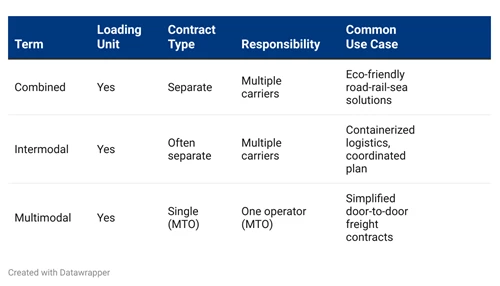Thanks to multimodal transport, you can benefit from the many advantages of combining different transport modes. The result is optimization of delivery days, reduced inventory costs and limited environmental impact. In this article, we will tell you more about what multimodal transport means, give different examples of multimodal transport options, and gain a better understanding on how to choose the right transport solution.
What is multimodal transportation?
Multimodal transport means that the logistics chain involves two or more modes of transport that are handled within the framework of a single transport agreement. For example, it may include air, sea, road, and rail freight. Standardized shipping containers are often used here, which can be easily transferred between the various transport options without the need for time-consuming reloading.
Within the EU, multimodal transport is considered a central part of the initiative to reduce greenhouse gas emissions. The European Economic and Social Committee (EESC) calls for an update of the regulatory framework as well as investment to promote more integrated flows.
What is multimodal transport ADR?
Multimodal transport involving dangerous goods often includes road transport segments that must comply with ADR regulations. ADR stands for the European Agreement concerning the International Carriage of Dangerous Goods by Road. It sets the legal framework for the safe and standardized transport of hazardous materials by road across European borders.
When road transport is part of a multimodal logistics chain (e.g., road + rail or road + sea), the ADR regulations apply to the road leg to ensure consistent safety standards.
Differences between combined, intermodal and multimodal transport
Understanding the difference between combined, intermodal, and multimodal transportation is important for understanding how each approach integrates different transportation methods and supply chains.
Combined and multimodal transport are strategies for moving goods between different transport methods. Combined transport involves the use of different vehicles without central coordination, while intermodal transport is characterized by a unit load that is interchangeable between different routes. On the other hand, multimodal transport is defined by the integration of several transport methods under a single agreement and coordinated management.
Combined transport:
Combined transport uses different transport methods, but each sector operates under separate agreements, without unified management.
Intermodal transport:
Intermodal transport involves moving goods in one loading unit across different transport modes, usually with separate carriers but under a unified logistics plan.
Read more about intermodal transport here.
Multimodal transport:
Multimodal transport combines two or more methods of transportation under a single agreement, where one person is responsible for managing and coordinating the entire operation.

What is an example of multimodal logistics?
The different types of multimodal transport represent strategic combinations of different transport methods to meet specific needs within the logistics and supply chain. Here are some examples of multimodal transport:
1. Sea and ground transportation
This type of multimodal transport combines the efficiency of sea transport with the flexibility of ground transportation – for example road transport or rail transport.
It usually involves transporting a container from a port to a remote area or the final destination. Ships are efficient for long distance transportation, and therefore trucks or trains are used to transport goods to specific locations.
2. Rail + other transport methods
Here, the load capacity and efficiency of rail transport is used to transport large quantities over long distances. The goods can then be transferred to other means of transport, such as trucks or ships, to reach more specific locations or locations that cannot be reached by rail.
3. Air + ground/sea transport
For this method, air freight is combined with other methods to ensure fast and safe delivery. A combination is often used to transport goods from domestic airports, using trucks or ships if necessary.
Read also: How can air freight improve supply chain optimization?
4. River + ground transport
This multimodal transport method uses waterways to transport goods across rivers. Goods can be transported by truck or train from river ports to reach final destinations directly connected to the sea.
5. Intercontinental transport
This transport option combines different transport methods such as sea, rail and road transport to facilitate the movement of goods between continents.
The use of intermodal containers plays an important role here, as they allow goods to be transported directly and without handling between different modes of transport. Each type of multimodal transport has its own advantages depending on the type of cargo, distance and time span.
The key is effective planning and coordination to ensure smooth transitions between different modes of transport and maximize logistics efficiency.
What are the advantages of using multimodal transport?
One of the advantages of choosing multimodal transport is that you get a one-stop-shop service with a large geographical reach and flexibility. Every single aspect of your freight transport is handled by your transport company. This ensures efficient delivery times and reduced costs for inventory and logistics.
Why choose Bertling for multimodal transport?
Are you looking for an optimal solution for multimodal transport? Bertling delivers tailored global transport solutions with a high degree of flexibility in our configurations. Our vision is to work proactively and meet new challenges as they arise.
Today, we offer a complete range of logistics services, including air- and sea freight, road transport, rail freight, project logistics and warehousing. When you are looking for a combination of the different transport options, we assist with that. All so you can take part in a fast, flexible, and environmentally friendly solution.
